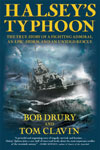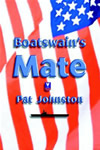Admiral Joseph Mason Reeves
(20 November 1872 - 25 March 1948)
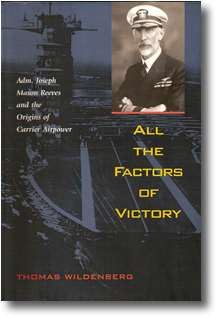 In a superbly written book, Thomas Wildenberg has captured the essence of a man who left little behind to describe himself and his life. It is only through the exhausing efforts of Mr. Wildenberg that we are given a substantial glimpse of a man who created the concept of Carrier Airpower.
In a superbly written book, Thomas Wildenberg has captured the essence of a man who left little behind to describe himself and his life. It is only through the exhausing efforts of Mr. Wildenberg that we are given a substantial glimpse of a man who created the concept of Carrier Airpower.
Admiral William A. Moffett is considered by many to be the father of Naval Aviation just as General "Billy" Mitchell is considered to be the father of the Army Air Corps and Air Force. It was Admiral Joseph Mason Reeves who was the father of Carrier Airpower. In his early days at the Naval War college, then-Captain Reeves explored theoretical tactics using air coverage to extend the targeting range of surface combatants.
From before the Spanish-American War until October 1944 (The Battle of Leyte Gulf, Phillipines), battleships ruled the seas and were the center of any battle doctrine. Of extreme interest in a Navy constrained by total tonnage, ship type, gunnery capacity and parity with other nations, something new was required to make the U.S. Fleet more combat effective and militarily significant in those dark days between World Wars. It had been prophesied as early as 1914 by British Admiral Percy Scott that battleships would soon be made irrelevant by aeroplanes. To Captain Reeves, it was imperative to extend the gunnery range of our treaty-limited and Congressionally constrained Naval assets. And that, to Captain Reeves, meant controlling the battle air space.
But Reeves was first founded in the surface Navy, a "skimmer" in our Navy parlance.
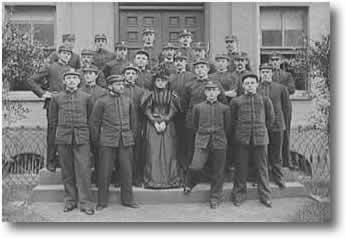 Attending the U.S. Navy Academy from June 1890 to June 1894, Cadet Midshipman Reeves excelled in sports, mathematics and engineering. Due to his mechanical abilities, MIDN Reeves was easily accepting into the special engineering currriculum in his First Class year to prepare him for future duty in the Engineering Corps. At that time, line officers did not serve in the engineering spaces.
Attending the U.S. Navy Academy from June 1890 to June 1894, Cadet Midshipman Reeves excelled in sports, mathematics and engineering. Due to his mechanical abilities, MIDN Reeves was easily accepting into the special engineering currriculum in his First Class year to prepare him for future duty in the Engineering Corps. At that time, line officers did not serve in the engineering spaces.
Passed Cadet Reeves stand in the middle of the second row from the top, above the young woman who posed with the class.
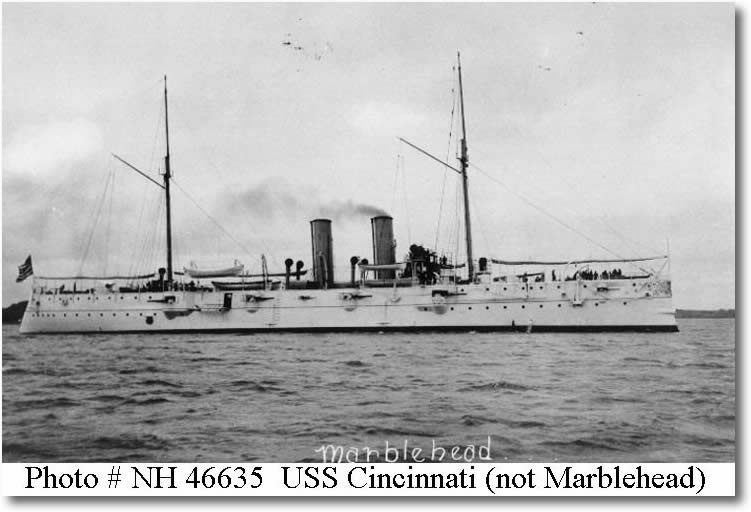 As part of a two year training program, Passed Cadet Reeves reported to the U.S.S. Cincinnati (C-7) after graduation from the U.S. Naval Academy in June 1894. As a follow-on to his engineering training at the Academy, his task was to successfully complete in the Engineering Division examinations two years after graduation, prepare for fleet assignment to the Engineering Corps and to become thoroughly familiar with the boiler room and machinery. There he learned the duties of an assistant engineer and was detached five months later on 11 December 1894.
As part of a two year training program, Passed Cadet Reeves reported to the U.S.S. Cincinnati (C-7) after graduation from the U.S. Naval Academy in June 1894. As a follow-on to his engineering training at the Academy, his task was to successfully complete in the Engineering Division examinations two years after graduation, prepare for fleet assignment to the Engineering Corps and to become thoroughly familiar with the boiler room and machinery. There he learned the duties of an assistant engineer and was detached five months later on 11 December 1894.
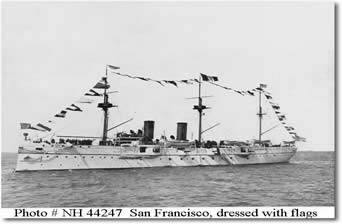
Immediately embarking on U.S.S. San Francisco (C-5), Cadet Reeves served for fifteen months further learning the engineering aspect of ship's life while deployed to the Mediterranean as part of a show-the-flag cruise. Upon returning to Annapolis in 1896, Cadet Reeves succeeded in ranking highest in his division which earned him a very prized billet on a brand new battleship.
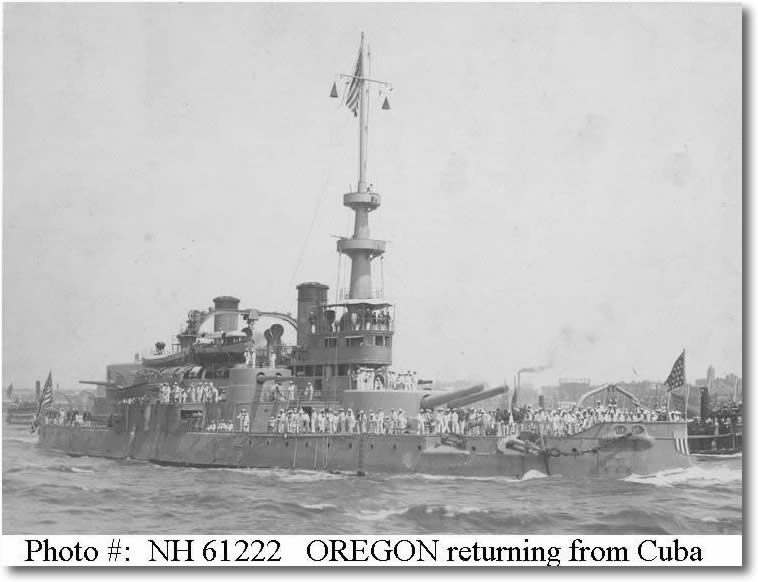
It was on the U.S.S. Oregon (BB-3) that Assistant Engineer Reeves saw his first and only battle action. Homeported in San Francisco, Oregon sortied on 19 March 1898 enroute to the East Coast as support for the Atlantic Squadron in preparation for the Spanish-American War. Without the Panama Canal, the Oregon made the long voyage south and rounded the Horn of South America. It was on that trip that Reeves really began to show his ability to take charge and help get the mission accomplished. When passing through the Straits of Magellan, the weather was it's usual rotten self. Reeves disobeyed orders and ran his engine room using forced draft, a practice not fully appreciated or approved due to the extreme temperatures in the engineering spaces. In doing so, the Oregon made the transit entirely in daylight hours. However, without it, the Oregon would not reach Sandy Point, Argentina in time to meet their next coaling rendevous.
The great detail of Oregon's passage are contained in Mr. Wildenberg's book. Suffice it to say, the above paragraph is a very brief synopsis of his research.
Oregon eventually joined in the blockade at Santiago de Cuba where it effectively engaged blockade runners in offensive gunnery and successfully pursued the fleeing Cristobal Colon on 3 July 1989. Much of Reeves engineering prowess was essential to overhaul and capture of the escaping Spanish cruiser.
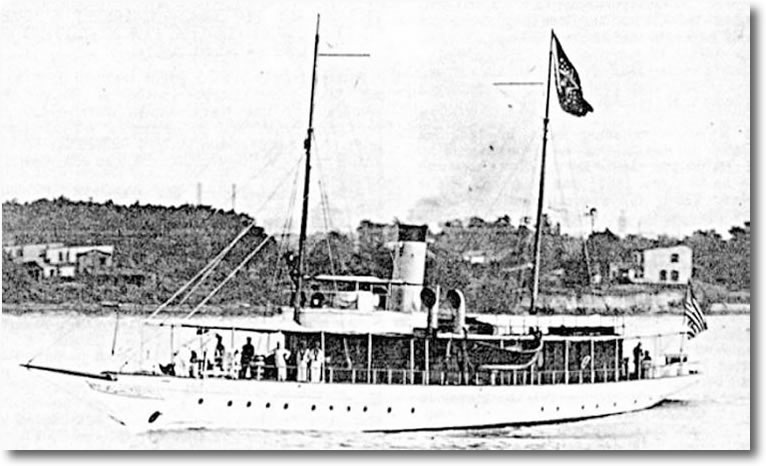 Assistant Engineer Reeves was detached from Oregon in October 1898 and reported to the presidential yacht Sylph, moored at the Washington Navy Yard. It was while serving as Engineer, that Congress abolished the Engineering Corps on 3 March 1899. At that moment, he assumed the rank of Ensign as a line officer. Shortly thereafter, he was promoted to LT(jg) and began to assimilate the intracacies of navigation, seamanship and gunnery. ENS was detached from Sylph in January 1900.
Assistant Engineer Reeves was detached from Oregon in October 1898 and reported to the presidential yacht Sylph, moored at the Washington Navy Yard. It was while serving as Engineer, that Congress abolished the Engineering Corps on 3 March 1899. At that moment, he assumed the rank of Ensign as a line officer. Shortly thereafter, he was promoted to LT(jg) and began to assimilate the intracacies of navigation, seamanship and gunnery. ENS was detached from Sylph in January 1900.
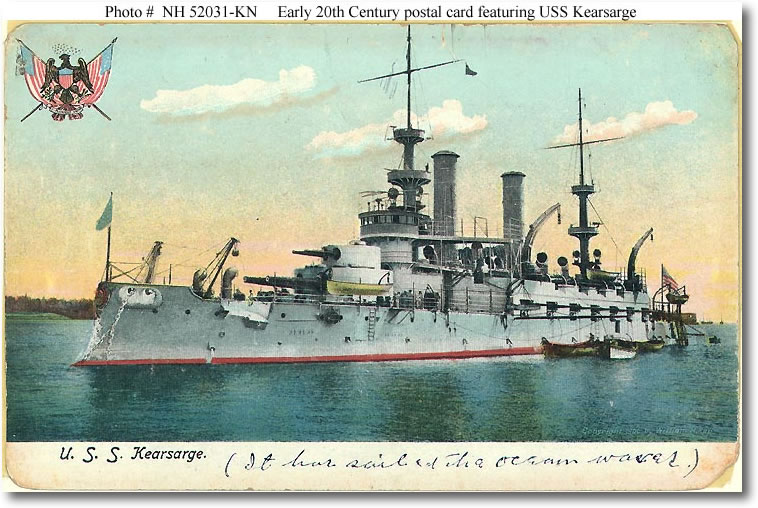
U.S.S. Kearsarge was a brand new commissioned ship the day that LT(jg) Reeves stepped aboard in February 1900. It was there that his instruction in seamanship and navigation began in earnest. He was also responsible for the port side battery of 5 inch guns (shown here). It was there that Reeves learned about the vagarities of Naval Gunnery, as it was practiced then.
1901-1902 - Naval Torpedo Station & Navy Gun Factory, Full Lieutenant
1903-1904 - USS San Francisco, Gunnery
1904-1905 - USS Wisconsin, Gunnery
1905-1906 - CINC Asiatic Fleet, Fleet Gunnery
1906-1908 - USNA, Physics, Chemistry, Engineering, LCDR
1908-1909 - USS New Hampshire, Ordnance
1909-1910 - CINC Atlantic Fleet, Fleet Gunnery
1910-1913 - Fleet Coaling Station, Tiburon, OIC
 U.S.S. Jupiter (Collier No. 3) as it appeared after LCDR Reeves assumed command (his first) on 5 May 1913. Jupiter was commissioned 7 April 1913 and was one of the largest ships in the Navy. Reeves had been given this command because of his repeatedly demonstrated capabilities as an engineer and masterful solutions to power plant and munitions handling equipment. Jupiter was still in its experimental stages and required a keen mechanical eye to solve to complex issues of coal handling in both an inport and underway environment. At the time of this photo, Reeves had just been promoted to Commander. The ship was scheduled for preliminary trials the following month. CDR Reeves was detached from Jupiter in May 1914 before taking her to sea in a fully operational status.
U.S.S. Jupiter (Collier No. 3) as it appeared after LCDR Reeves assumed command (his first) on 5 May 1913. Jupiter was commissioned 7 April 1913 and was one of the largest ships in the Navy. Reeves had been given this command because of his repeatedly demonstrated capabilities as an engineer and masterful solutions to power plant and munitions handling equipment. Jupiter was still in its experimental stages and required a keen mechanical eye to solve to complex issues of coal handling in both an inport and underway environment. At the time of this photo, Reeves had just been promoted to Commander. The ship was scheduled for preliminary trials the following month. CDR Reeves was detached from Jupiter in May 1914 before taking her to sea in a fully operational status.
 U.S.S. Oregon (BB-3) as it appeared at anchor in San Francisco Bay during the Panama-Pacific International Exposition in 1915. CDR Reeves assumed command in Bremerton, WA on 15 January 1915 and immediately took Oregon to San Francisco. She remained on station off the Presidio locale of the Exposition until it closed 4 December.
U.S.S. Oregon (BB-3) as it appeared at anchor in San Francisco Bay during the Panama-Pacific International Exposition in 1915. CDR Reeves assumed command in Bremerton, WA on 15 January 1915 and immediately took Oregon to San Francisco. She remained on station off the Presidio locale of the Exposition until it closed 4 December.
Shown below is a panoramic view of the Exposition from the decks of the Oregon. This photo was taken barely nine years after the destruction of the City after the earthquake of 18 April 1906.

 Following his assignment to Oregon, CDR Reeves spent a year as Senior Aide to the Commandant, Mare Island Navy Yard. With the outbreak of World War I, opportunities emerged for early assignments to sea for many less than senior officers. While Oregon was a vintage and historic battleship, U.S.S. Maine (BB-10) represented the culmination of every Naval officer's sea-going career - command of a 20th century battleship. This was particularly unusual for an officer who had not yet achieved the rank of Captain. CDR Reeves remained in command until August 1918 when he was transferred to shore duty in Washington, D.C.
Following his assignment to Oregon, CDR Reeves spent a year as Senior Aide to the Commandant, Mare Island Navy Yard. With the outbreak of World War I, opportunities emerged for early assignments to sea for many less than senior officers. While Oregon was a vintage and historic battleship, U.S.S. Maine (BB-10) represented the culmination of every Naval officer's sea-going career - command of a 20th century battleship. This was particularly unusual for an officer who had not yet achieved the rank of Captain. CDR Reeves remained in command until August 1918 when he was transferred to shore duty in Washington, D.C.
Although Maine did not see any battle action during World War I, she played an important role in training the hordes of sailors who enlisted in the period 1917-1919.
Over a period of a few years, first as a student and then department head at the War College, he explored Naval aviation as the answer to the fleet's many tactical problems. Captain Reeves repeatedly demonstrated in war game after war game that control of the air space was the first priority for any fleet commander. As Commander, Air Squadrons, Battle Fleet - his next assignment in 1925 - Captain Reeves began to implement significant changes to the way that the Navy viewed and operated their aircraft. As a senior Captain, he was too old to qualify as a pilot. However, a well place mentor in Washington made it possible for Captain Reeves to qualify as an Naval Aviation Observer - which made it possible for him to become ComAirRons.
...
There is a lot more history to be inserted at this point. For the moment, let it be said the rest of the story of Admiral Reeves has yet to be placed on this page. As an opener, think carriers, Navy Air Warfare doctrine and World War II.
© 2008 USS Reeves Association. All rights reserved. Last update: 9/20/2008



